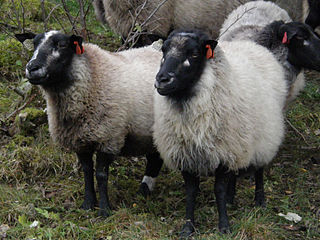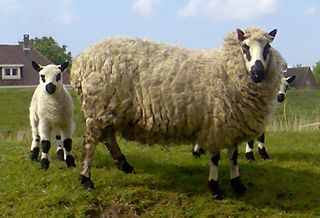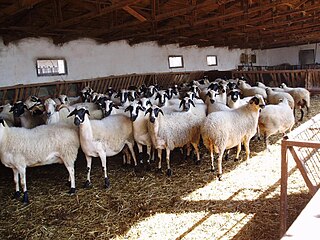
The Karayaka (Black Neck) is a breed of domestic sheep from Turkey. It is a dual purpose breed producing meat and milk. The wool is used in carpets. The Karayaka is classified as a long thin-tailed breed. [1]

The Karayaka (Black Neck) is a breed of domestic sheep from Turkey. It is a dual purpose breed producing meat and milk. The wool is used in carpets. The Karayaka is classified as a long thin-tailed breed. [1]
Usually, the Karayaka is white with black eyes, head and legs. Infrequently, brown or black animals are seen. Most of the time, rams are horned and ewes are polled (hornless). [1]
On average, ewes are 61.1 cm (24.1 in) at the withers and 67.4 cm (26.5 in) long. Also, ewes weigh 35 to 40 kg (77 to 88 lb) and produce 40 to 45 kg (88 to 99 lb) of milk in a 130- to 140-day lactation period. In a study, it was found that ewes produce about 1.8 to 2.4 kg (4.0 to 5.3 lb) of fleece with a 21 to 28 cm (8.3 to 11.0 in) staple length and 39 to 43 micron diameter. [2]

The Lincoln, sometimes called the Lincoln Longwool, is a breed of sheep from England. The Lincoln is the largest British sheep, developed specifically to produce the heaviest, longest and most lustrous fleece of any breed in the world. Great numbers were exported to many countries to improve the size and wool quality of their native breeds. The versatile fleece is in great demand for spinning, weaving and many other crafts.

The Border Leicester is a British breed of sheep. It is a polled, long-wool sheep and is considered a dual-purpose breed as it is reared both for meat and for wool. The sheep are large but docile. They have been exported to other sheep-producing regions, including Australia and the United States.
The Dagliç is a breed of sheep found primarily in western Anatolia in Turkey. They are a carpet wool breed used for both meat and dairy production. Sheep of this breed typically have black spots on the head and legs, the rams are usually horned and the ewes are polled. The breed is thought by some to be the origin of the Chios and Kamakuyruk breeds.

The Oxford Down is an English breed of domestic sheep developed in the 1830s by crossing the Cotswold, Hampshire and South Down breeds, and using the resulting cross-breeds to form the basis of the present-day breed. This breed is primarily raised for meat.

The Norwegian Grey Troender is a very rare breed of domesticated sheep that originated from crossbreeding native landrace sheep with the now extinct Tautra sheep in the late 19th century. There are currently approximately 50 individual animals, nearly all residing within Norway.

The Kerry Hill is a breed of domestic sheep originating in the county of Powys in Wales. It derives its name from the village of Kerry (Ceri), near Newtown. Kerry Hill sheep have a distinctive and unique coloration, with a white face bearing black markings around the mouth, ears, and eyes. Both rams and ewes are polled. Their wool is white, and their legs are white with black markings. First mentions of the breed date back to the early 19th century, and today it is distributed throughout the United Kingdom, Ireland, the Netherlands, Germany and Denmark. Though still not very numerous, the breed was removed from the records of the Rare Breeds Survival Trust watchlist in 2006. This breed is primarily raised for meat.

The Basco-béarnaise is a domesticated breed of sheep originating in the Basque country. The breed was developed from Basque and Béarnaise sheep during the 1960s to be a single-purpose milk breed.

The Racka or Hortobágy Racka Sheep(Ovis aries strepsiceros hungaricus) is a breed of sheep known for its unusual spiral-shaped horns. These unique appendages are unlike any other domestic sheep horns, and may grow up to 2.0 ft (0.61 m) long. The smallest standard length is 20 in (51 cm) for rams and 12–15 in (30–38 cm) for ewes.

The Beulah Speckled Face is a breed of domestic sheep originating in the United Kingdom. Having been bred in the uplands of Wales for more than a hundred years, a breed society was officially formed in 1958. This breed is most common in Eppynt, Llanafan Fawr, Abergwesyn, and Llanwrtyd Wells, and it is little known outside Wales. The origins of the breed are unclear; it may be a truly native breed that has been selected to suit the local environment for centuries. The breed is named for its distinctly patterned black and white face, which is free from wool. The ewes, which are naturally polled, are often crossed with lowland rams such as the Suffolk, Texel or Bluefaced Leicester to breed mules, and to produce market lambs for meat. When bred pure, the lambs do not meet today's export demand for lean, fast-growing sheep. However, the ewes make good mothers and produce plenty of milk.
Arabi is a domesticated breed of sheep from southwestern Iran, southern Iraq and northeastern Arabia and Egypt. Though it does grow wool, it is primarily raised for meat.

Algerian Arab sheep is a breed of domesticated sheep found throughout Algeria. This breed does grow a carpet-grade wool, and is raised primarily for meat.
The Balkhi is a domesticated breed of sheep found in Afghanistan and North-western Pakistan. This breed is of the fat-tailed mutton type. Though this breed does grow wool, it is primarily raised for meat.
The Baluchi is a domesticated breed of sheep originating from now southwest Pakistan, eastern Iran and southern Afghanistan. It is a member of the fat-tailed breed. The Baluchi is raised primarily for wool.

The Bardoka or White Metohian sheep is a multi-purpose breed of domesticated sheep in Kosovo. It is a popular sheep in Kosovo and partially in Montenegro, Serbia and Albania. This breed appears to adaptable to all environmental conditions especially low temperatures. However, the Bardoka is sensitive to high humidity.
The Bibrik is a fat tailed, domesticated breed of meat sheep that is found in Baluchistan Province of Pakistan.
The British Milksheep is a robust, dual-purpose sheep commonly known for its milking characteristics.

The Chios is a breed of domestic sheep with specific unknown origins. It is classified as a semi-fat tailed breed. The Chios are bred mainly for their milk production. Although there is speculation that this breed may have been crossed with Kivircik and Dagliç, it is commonly accepted that it originated on the Greek island of Chios.
The Cholistani is a breed of domestic sheep from Pakistan. Though the Cholistani grows wool, it is raised primarily for meat.

The Coburger Fuchsschaf is a breed of domestic sheep from Germany. It is characterized by its reddish brown to golden color, which is most pronounced at birth, but remains at the head and the legs in the adult. Many animals also have a dorsal stripe.
Edilbay sheep, also known as Edilbaev(skaya) sheep, are a breed of domesticated sheep which originated in northern Kazakhstan. This breed belongs to the coarse-wooled fat-tailed type of sheep and the Kazakh group. It originated in the 19th century as a cross between Kazakh fat-tailed sheep and Kalmyk/Astrakhan coarse-wooled sheep. Today, it is found in Kazakhstan and Russia.
| Wikimedia Commons has media related to Karayaka . |